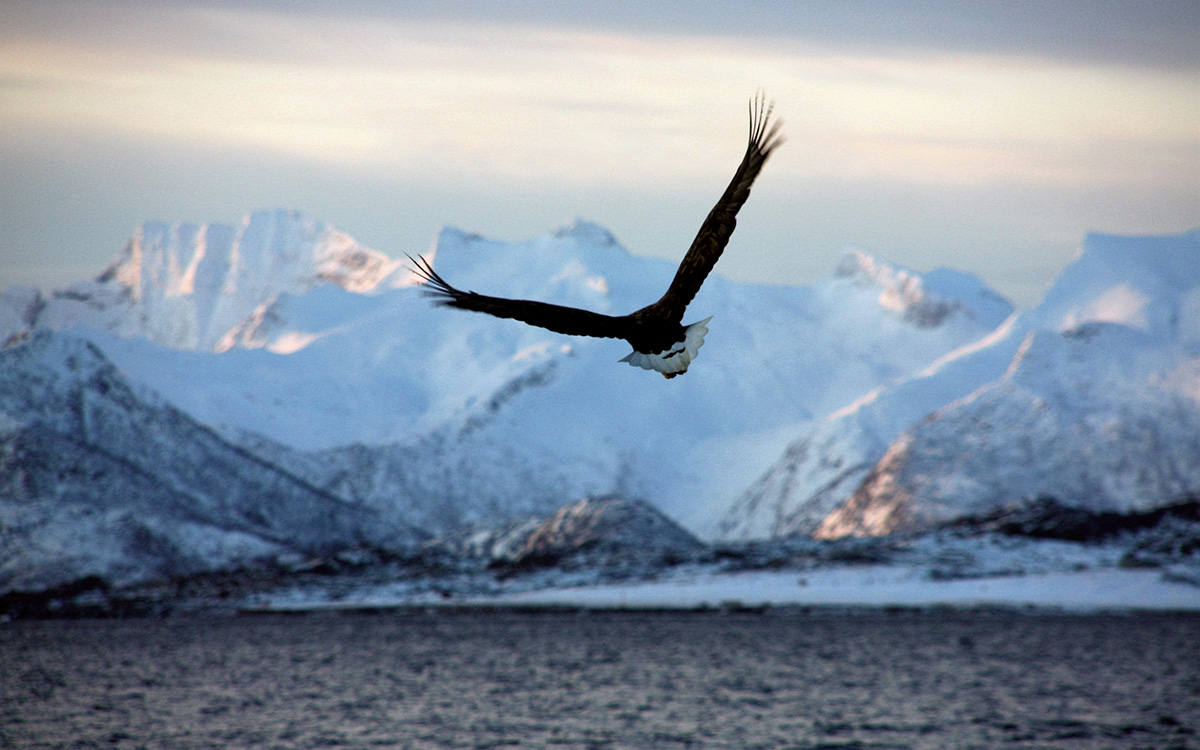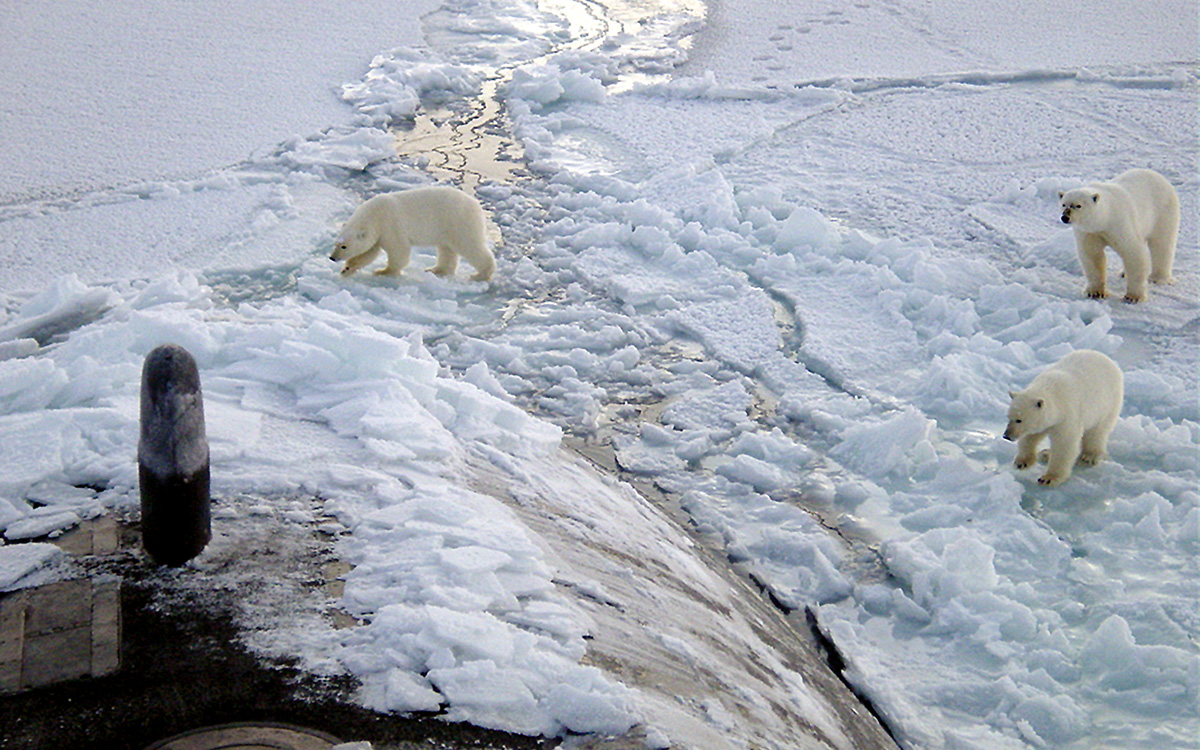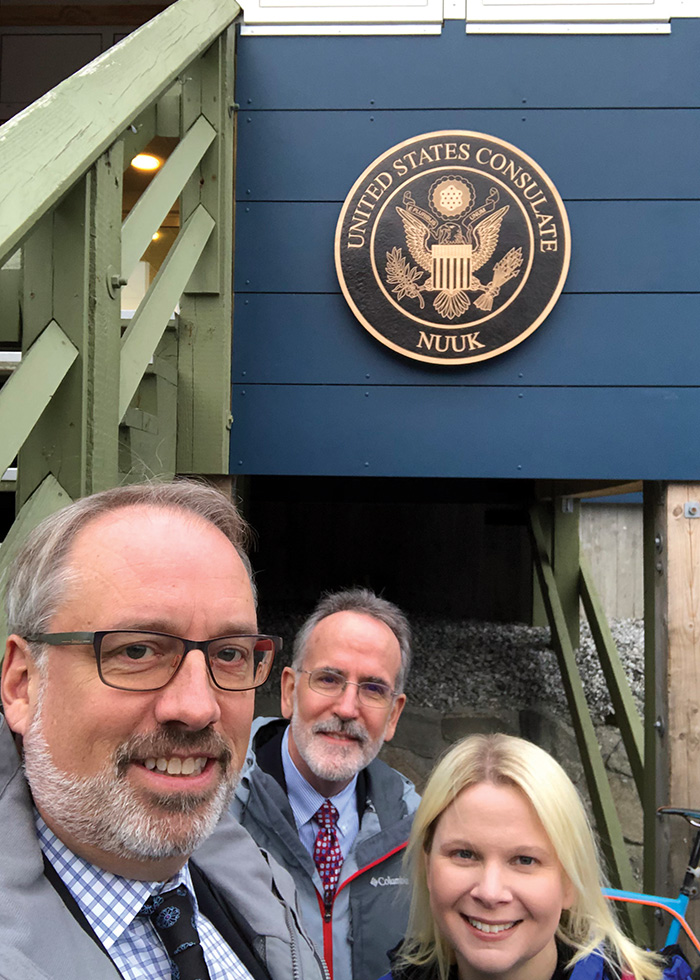A Balanced Approach to the Arctic—A Conversation with U.S. Coordinator for the Arctic Region James P. DeHart
The Arctic is a place of cross-cutting interests—security, science and economic development, among others—and the different pieces need to fit together.

An eagle flying near Nuuk, Greenland, in October 2020.
Hilary Lebail
Shawn Dorman: What is the role of the U.S. coordinator for the Arctic region? When and why was the position created?
Jim DeHart: The previous administration created the position last July and asked me to fill it. The logic of having a coordinator was to ensure we were taking a balanced approach to the Arctic region, giving attention to the full range of U.S. interests there—security, scientific research, Coast Guard cooperation, economic development and so on—and integrating these interests into a coherent approach. This is even more important because the Arctic is changing rapidly due to climate change and becoming more accessible to all sorts of new activities.
SD: What are the major U.S. priorities in the Arctic?
JDH: Fundamentally, we want to make sure the region remains peaceful, free of conflict without any threats to our homeland, and a place where international cooperation prevails. We want residents of the Arctic, including Indigenous communities in our own state of Alaska, to prosper. And now, with the new administration, we have a major focus on tackling the climate change crisis, a global effort in which the Arctic is a critical domain because it’s warming much faster than the rest of the planet. Our renewed focus on climate is very much welcomed by our allies and partners in the Arctic region, with whom we work very closely.
SD: What’s the home bureau for the coordinator? Who do you work with inside State and among other U.S. government, nongovernmental and international entities?
JDH: We are an S-slash office [S/AR], not resident in any bureau, which I think makes sense because we need to work across all interested bureaus and offices, each of which views the Arctic through its own particular lens. The Arctic is a place of cross-cutting interests—security, safety, science, economic development, to name a few—and the different pieces need to fit together. We’re a small office, only four of us, so you might say we’re sparsely populated, like the Arctic. We work across the federal government and do a lot of outreach with organizations such as the Wilson Center and the Center for Strategic and International Studies, the Alaska congressional delegation, Alaska Native communities, and the large orbit of scientists and other professionals dedicated to Arctic work.
SD: Compared to some other regions, the Arctic has an unusually large interagency footprint. And now the military service branches are releasing separate Arctic strategies. To what extent is Arctic policy fragmented among the various agencies and services? Is there a role for State to play in bridging priorities and overcoming the fragmentation?
JDH: Yes, just since last July, we’ve seen new Arctic strategies from the U.S. Air Force, Navy, Army and Department of Homeland Security. The common denominator among them is increased U.S. attention and presence. Clearly, there’s a growing sense of the Arctic as a distinct realm of U.S. foreign and security policy, and different parts of the U.S. government are working to keep pace with developments there. As our new administration sets out its vision for the region, State can undertake the essential diplomacy, and we may see updates by the service branches to align with the new administration’s priorities.
SD: Does your office coordinate with the new U.S. Special Presidential Envoy for Climate John Kerry? If so, how?
JDH: Yes, we are coordinating closely with his team. We must leverage our diplomacy in the Arctic region, including through the Arctic Council, to advance our administration’s broader climate change goals.
SD: You mention the Arctic Council. With so much new interest and activity in the region, is the Arctic Council still the best venue for international Arctic cooperation?
JDH: Yes, absolutely. We see the Arctic Council as the region’s premier multilateral forum. Through the years, we’ve negotiated significant agreements on pollution control and response, on search and rescue, and on scientific cooperation. A lot of very concrete work takes place in the various working groups, somewhat under the radar. It’s also unique in that the Native and Indigenous peoples of the region have a seat at the table together with the eight Arctic governments. And it’s a rare venue where the United States and Russia cooperate productively. This year is the 25th anniversary of the Arctic Council, and we’re looking forward to the chance to advance Arctic diplomacy at the ministerial meeting hosted by Iceland on May 19-20.

Three polar bears approach the USS Honolulu while it surfaced 280 miles from the North Pole in 2003. Today, polar bears are a vulnerable species due to sea ice loss from climate change.
U.S. Navy
SD: What do you anticipate will change when Russia assumes chairmanship of the Arctic Council for a two-year term at the end of the ministerial? What are your concerns?
JDH: We’re prepared to work with the Russian chair, as we have with previous chairs. We see opportunities for cooperation, including on climate. We look to Russia to adhere to Arctic Council norms and practices, and to sustain the council’s circumpolar focus—meaning continued attention to the needs of the entire Arctic region.
SD: What are U.S. concerns about Russian influence and activity in the region?
JDH: Let me first point out that the Arctic Council does not do military security. We address those issues, together with our allies, outside the council, through NATO and other means. In that context, we have serious concerns about Russia’s military buildup in the Arctic, its aggressive military exercises and the lack of transparency in some of its military activities. We have also expressed our concern about Russia’s regulation of the Northern Sea Route, which is not in accordance with international norms.
SD: When it comes to U.S. Arctic policy, where is the balance between environment, climate change and sustainability on one hand, and security and economic interests on the other?
JDH: All these interests are crucial, and I think we should try to align our efforts as much as possible. For example, remote communities across the region are desperate for investment to create jobs and livelihoods. The right kinds of investment, for example in renewable energy, can support those communities while also contributing to our climate change goals. In doing so, we can guard against unsustainable investments by others that could be damaging to local communities—and undermine our security interests, as well.
SD: You’re talking about China?
JDH: Yes, mostly. We’ve seen how Beijing has done things elsewhere in the world, and all too often China’s investment activities have led to unsustainable debt, environmental damage, unkept promises in terms of developing the local labor force, a lack of transparency leading to corruption and other problems. We think that sort of unsustainable development has no place in the Arctic.
SD: So how should the U.S. handle the significant interest China—a non-Arctic nation—has shown in the region?
JDH: We’re not saying no to all investment by China, but we are insisting on transparency and adherence to high standards and local requirements. We also think it’s necessary to have investment screening laws so that investments touching on critical infrastructure—for example, ports, airports and digital networks—are looked at through a national security lens. The Chinese have shown a great deal of interest in acquiring critical infrastructure across the Arctic region, and that is definitely a concern.
SD: Is the United States behind in the “race for Arctic resources”? What does that even mean?
JDH: We don’t see a race for resources in the Arctic. Although the physical changes taking place are dramatic, it’s going to remain a challenging operating environment for a long time to come. As the sea ice recedes, we’ll see more shipping, more tourism and more economic activity, and the Arctic will become a busier place. But I think this will happen over decades, not overnight. Still, we need to prepare for this inevitable transformation. It’s sort of a strategic planner’s dream.

Jim DeHart, State Department Senior Oceans Policy Adviser Gregory O’Brien and Office of the U.S. Coordinator for the Arctic Region Senior Adviser Hillary LeBail during an October 2020 visit to the U.S. consulate in Nuuk.
Jim DeHart
SD: But isn’t there a larger geopolitical competition that’s taking place in the Arctic?
JDH: Countries around the world see the Arctic becoming more accessible. So, many of them are developing the capabilities required to be more present and involved in the future, such as icebreakers. But keep in mind: The Arctic is not “ungoverned” space. There are rules in the Arctic, starting with the U.N. Convention on the Law of the Sea, which puts most of the resources within the territorial jurisdictions of the Arctic states. Connected to this is a well-functioning international process to settle the extended continental shelf claims, the seabed claims, of the Arctic states. These rules and frameworks help keep things predictable and peaceful.
SD: Wait, but the U.S. hasn’t signed the convention. Do we still follow the rules it lays out?
JDH: We do. We treat the Law of the Sea Convention as customary international law, and we follow it. It’s very much in our interest to do so.
SD: Would ratification of the U.N. Convention on the Law of the Sea affect the way the United States is able to influence events in the Arctic? Might the United States ratify UNCLOS in the coming months and years?
JDH: I think it’s unquestionably in our interest to become a formal party to the agreement, especially as we prepare to submit our own extended continental shelf claim in the Arctic; but putting this question to the Senate entails many considerations beyond my remit.
SD: How is science diplomacy playing out in the Arctic? Is this an area of broad cooperation, including with competitors?
JDH: Yes. I don’t know of any other region of the world, except maybe Antarctica, where international collaboration on science is so strong. The work we do in the Arctic with our international partners is amazing, and especially critical to understanding climate change and projecting future trends. By the way, this includes not just the states of the Arctic, but many great partners from outside the Arctic region, as well. I’m proud to say the United States leads the way on Arctic science, and I have the utmost admiration for the work of the National Science Foundation, National Oceanic and Atmospheric Administration, NASA and our science community writ large. NASA has a satellite that measures the depth of the Greenland ice cap with precision down to the width of a pencil!
SD: What are the priorities for our new consulate in Nuuk, Greenland? Has there been concern from locals or from Denmark about that time when the U.S. president talked about buying Greenland?
JDH: As you know, we have consulates all over the world, which enable us to reach beyond capital cities and build relations with levels of society and communities that might otherwise be difficult to reach. Greenland is a uniquely great place to have a consulate because it is so remote and has distinct cultures and communities that take some time to get to know. I had the chance to travel to Greenland in the fall, and I can tell you we have a great consulate team there. I think we’re now in a position to take our relations with the Greenlanders to the next level, including cooperation on sustainable tourism, new commercial opportunities and educational exchanges.
SD: So, we are not trying to buy Greenland?
JDH: We’re not in the real estate business. We’re in the diplomacy business, working to deepen our ties with the people of Greenland and, for that matter, with the entire Kingdom of Denmark. Denmark, of course, is a great friend and ally.
SD: What will success look like for the United States in the Arctic?
JDH: When the Arctic becomes synonymous with peace, with international cooperation, with good science, and with better futures for Arctic peoples—I think that’s success.
Read More...
- “Implementation Framework for the National Strategy for the Arctic Region,” by Arctic Executive Steering Committee, U.S. Department of State, March 2016
- “Cool Under Pressure,” by Ellen Summey, Army ALT Magazine, March 22, 2021
- “New Cold War: U.S. Names Arctic Policy Czar to Keep Tabs on China, Russia,” by Courtney McBride, The Wall Street Journal, July 29, 2020





